The MSP space is booming, expected to reach US$595 billion globally in 2025, growing roughly 13% year-over-year. Yet, with over 341,000 MSPs worldwide by year-end, especially in EMEA and North America, the market is more crowded than ever.
Cold outreach is getting less effective. Your potential clients aren't just looking for any IT provider: they want someone who clearly knows their stuff, can prove it, and actually gets their specific challenges.
That's where smart content marketing becomes your secret weapon. Think of it as having your best salesperson working around the clock, building trust and educating prospects so they're already halfway sold before you even hop on a call together.
This guide cuts through the fluff to give you both the big-picture strategy and the nitty-gritty how-to steps. We'll cover what's working in 2025: from AI optimization that helps you get found, to video content that people actually watch, to personalization that makes each visitor feel like you're speaking directly to them. All tailored specifically for MSPs who want results, not just busy work.
What Is MSP Content Marketing?
Content marketing for MSPs means creating and distributing helpful, relevant content, articles, videos, case studies, that prospectively builds trust and authority. It’s not about broadcasting your services; it’s about solving problems so your audience sees you as the obvious choice.
Why MSPs Must Go Beyond Generic B2B Marketing:
- Longer, consultative sales cycles (3–6 months).
- A tech-savvy audience that quickly dismisses vague messaging.
- The need for credibility and proof, MSPs must demonstrate reliability, not just capability.
For example: A blog titled “How This Local MSP Cut Client Downtime by 37%, Safeguarding $150k in Revenue” is far more compelling than a generic IT tip.
The MSP Buyer Journey: Understanding What Clients Want at Every Stage
Let’s walk through the stages your potential clients go through, and what kind of content actually moves them forward. Think of this as stepping into their shoes.
1. Awareness Stage – “We have a problem, but we’re still figuring it out.”
Here's what's really happening: A business leader knows something's broken—maybe their IT guy is always stressed and running around putting out fires, or they're reading another ransomware story and wondering if they're sitting ducks. That system outage last month? Three days of chaos and a hefty bill they're still feeling.
Yet, they're not searching for "managed service providers" because they've never heard that term. Instead, they're frantically Googling stuff like "why does our server keep dying" or "how do I know if my IT is working."
What they want: Someone who gets it. Content that helps them put words to that nagging feeling without immediately pitching them something. They need to see what's normal versus what's a red flag, and understand the real cost of doing nothing.
Content that works:
- Blog posts like “5 Signs Your Business IT Is Holding You Back”.
- Infographics on industry-specific risks (e.g., “Top Cybersecurity Threats for Law Firms in 2025”).
- Social media posts with quick, actionable tips.
Goal: Build awareness of the problem and position yourself as a trusted source, not a salesperson.
2. Consideration Stage – “We’re exploring options to fix this.”
Now they're in problem-solving mode. They've admitted their IT setup is holding them back and they're weighing their options: should they hire another tech person, stick with that local IT guy who takes forever to call back, or try this "managed service provider" thing everyone keeps talking about?
What they want: Someone to cut through the confusion. Clear comparisons that don't sugarcoat the pros and cons, real expert insights (not just sales fluff), and practical resources that actually help them make a smart decision instead of just adding to the overwhelm.
Content that works:
- Guides like “In-House IT vs. MSP: What’s Right for Your Business?”.
- Webinars with Q&A on how MSPs solve common issues.
- Downloadable IT security checklists they can use internally.
Goal: Educate and differentiate. Use your MSP content marketing to show where MSPs shine compared to other solutions.
3. Decision Stage – “We know we want an MSP, now which one?”
They've narrowed it down to you and a couple of other MSPs. This is where the rubber meets the road, they don't want more promises or fancy brochures. They want proof you can actually walk the walk.
What they want: Hard evidence that you're not just another vendor who'll disappear when things get tough. Real client wins, actual numbers, and that gut-level confidence that you're the team they can trust with their business.
Content that works:
- Detailed case studies with numbers.
- ROI calculators to project savings.
- Client testimonial videos.
Goal: Reduce risk in their eyes and make choosing you feel like the safe, smart move.
4. Retention Stage – “We already work together, keep proving your value.”
Once they’ve signed on, content still matters. Your role is to keep them engaged, aware of your value, and open to upselling opportunities.
What they want: Relevant updates, education on emerging threats, and proactive support ideas.
Content that works:
- Client-only newsletters with alerts (e.g., “Urgent Microsoft Patch Updates”).
- Proactive QBR reports showing performance improvements.
- Exclusive webinars for clients.
Goal: Strengthen the relationship, reduce churn, and expand their contract over time.
Key Content Formats for MSPs in 2025
Based on 2025 B2B benchmarks, 92% use short articles/posts; 76% leverage video; 75% rely on case studies. LinkedIn remains the top platform: 85% find it most valuable. You can expect continued growth in video investment (61%), thought leadership (52%), and AI-powered content creation/optimization (39–40%) [Source].
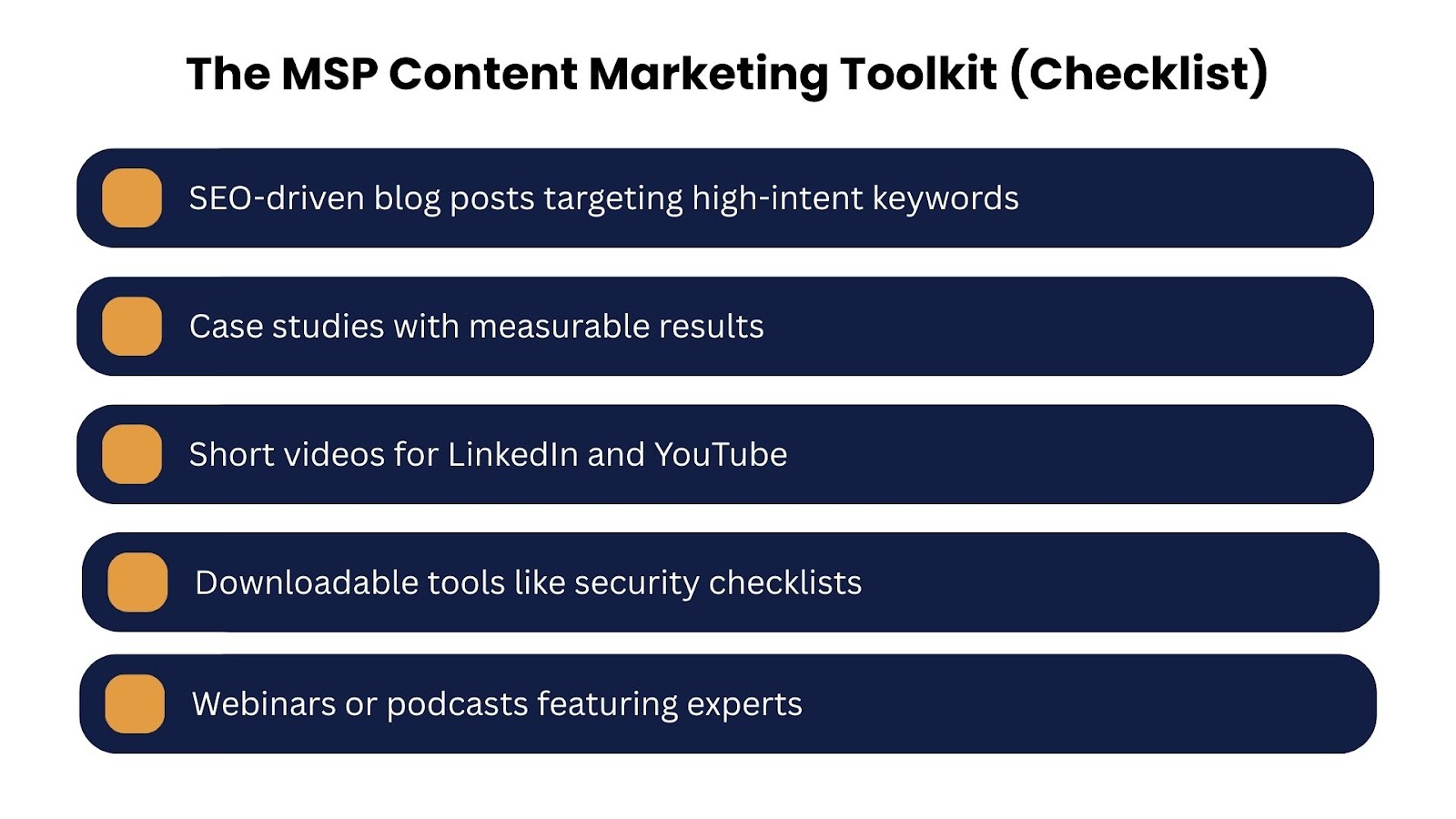
MSP Content Marketing Formats (Checklist)
How to Build Your MSP Content Marketing Plan (Explained)
Instead of a simple list, let’s walk through the steps together.
- Define Your Personas: Who are you talking to? The CFO of a manufacturing company will care about cost savings, while the Office Manager at a law firm might be more worried about compliance. Write for one persona at a time.
- Select Topics Based on Pain Points + Keywords: Start with real client questions. If you hear “What’s the difference between a break/fix IT service and an MSP?” twice in a month, make that your next blog.
- Match Topics to Formats: Blogs help you get found. Videos build trust. Webinars showcase expertise. Use each where it’s strongest.
- Plan a Realistic 90-Day Calendar: Don’t try to publish daily. One great blog, one LinkedIn post per week, and one webinar per quarter can be enough.
- Create Using AI Smartly: Let AI help brainstorm or draft outlines, but add your stories and insights. That’s what makes content connect.
- Promote & Repurpose: Share every blog on LinkedIn, turn it into a short video, email it to your list, and pull out one-liners for social posts.
- Track What Works: Don’t just look at traffic. Which pieces of content led to booked calls? That’s your measure of success.
Quick Wins to Get Moving Today
- Refresh your top 3 blogs – Add updated stats, make them AI Overview-friendly, and re-share them.
- Turn a client success into 3 formats – A blog, a LinkedIn post, and a short video.
- Add clear CTAs to all content – “Book a Free IT Consultation” or “Download the Security Checklist.”
These are small changes that can drive big results without waiting months. If you need faster results you can get help from MSP SEO Agency and get ahead of your competitors in just a couple of months.
MSP Content Marketing Tactics You Can’t Ignore in 2025
AI Overviews & Chat Search Optimization
Google’s AI Overviews and chat-based search mean more people get answers without clicking through. Format some of your content in Q&A style, with direct, concise answers and supporting data so you can still show up.
Generative AI for Personalization
AI isn’t just for writing: it can segment your audience and customize content (e.g., tailoring cybersecurity tips for healthcare vs. finance clients).
Content Repurposing
Don’t create from scratch every time. One webinar can become five blog posts, three LinkedIn posts, a checklist, and a video series.
LinkedIn Authority Building
Comment on industry news, share your take on emerging tech, and post behind-the-scenes MSP life to humanize your brand.
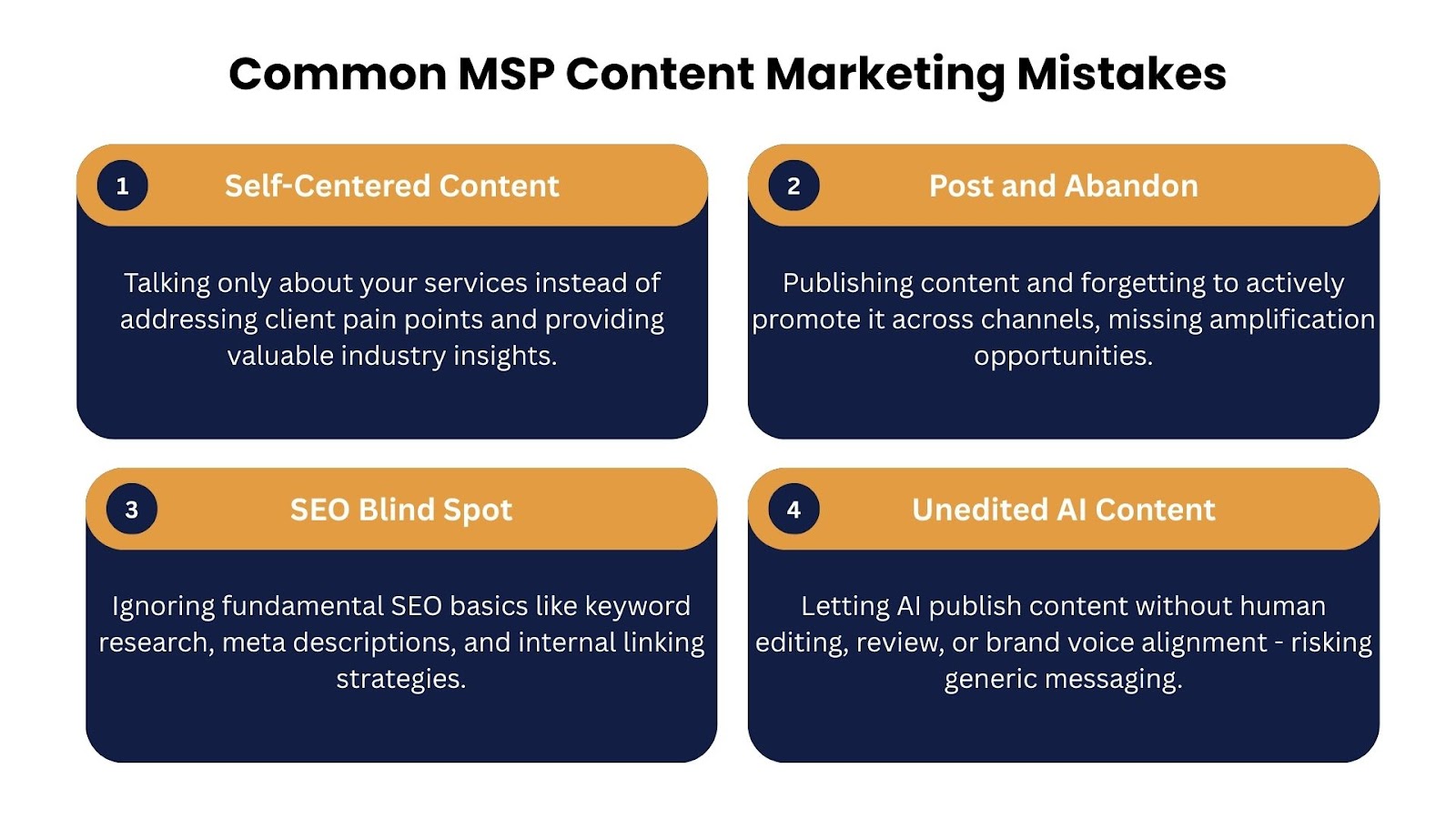
Common MSP Content Marketing Mistakes
Should You Outsource or Do In-House Content Marketing?
One of the first big decisions MSP leaders face is whether to keep content marketing in-house or hand it over to a specialized agency. The “right” choice depends on your resources, expertise, and how fast you want to see results.
Let’s be real, content marketing takes more than just writing a blog once in a while. It’s strategy, SEO, design, promotion, analytics… and doing it all consistently.
When In-House Makes Sense: If you have a marketing manager or team who already understands your services inside-out and has the time to execute, keeping it internal can work. The upside? Total control over your brand voice and deep knowledge of your clients. The downside? It’s easy for content to take a back seat when client emergencies pop up.
When Outsourcing Wins: Let's be real, your tech team is already drowning in client work and emergency fixes. You know you need consistent content that actually shows up in Google and turns website visitors into paying customers, but who has time for that?
Here's where the right marketing partner becomes a lifesaver. They're not just cranking out generic blog posts. They see your business with fresh eyes, catch trends you'd never notice (like how AI is completely changing search), and, here's the big one, they actually know how to make content that pays for itself by bringing in real leads. Plus, your developers can focus on what they do best instead of wondering why nobody's finding your amazing product online.
We have over 12 years of experience in MSP content creation. Reach out to us, and we’ll respond with an offer that could transform your MSP’s inbox for good!
Hybrid Approach: Finding the sweet spot: A lot of MSPs play it smart by splitting the difference. They let an agency handle the heavy lifting, strategy, SEO magic, and getting the word out, while keeping the really technical stuff and client success stories in-house.
Makes sense, right? You get professional marketing chops plus that authentic voice that only comes from people who actually live and breathe your technology every day.
Bottom line: Choose the route that keeps your content engine running consistently. A perfect content strategy that’s only executed “when we have time” won’t move the needle.
Conclusion
Content marketing for MSPs in 2025 is about relevance, trust, and strategic use of modern tools. You don’t need to do everything at once, you just need to consistently produce content that your target audience actually finds useful.
MSP content marketing should start small: choose one tactic from this guide, and commit to it. In a few months, you’ll see the shift: warmer leads, more informed prospects, and a stronger reputation in your niche.
FAQ
How do I market my MSP?
Focus on building trust and visibility. Combine SEO-driven content, LinkedIn thought leadership, case studies, and targeted email campaigns. Show real results from your clients and be consistent in sharing your expertise.
What are the 3 C’s of content marketing?
- Create valuable, relevant content.
- Curate resources your audience finds useful.
- Circulate your content through the right channels so it reaches decision-makers.
How to use content marketing for lead generation?
Answer your ideal clients’ biggest questions with blogs, videos, and guides. Offer downloadable tools (like IT checklists) in exchange for contact details, and use CTAs to guide readers toward booking a consultation.


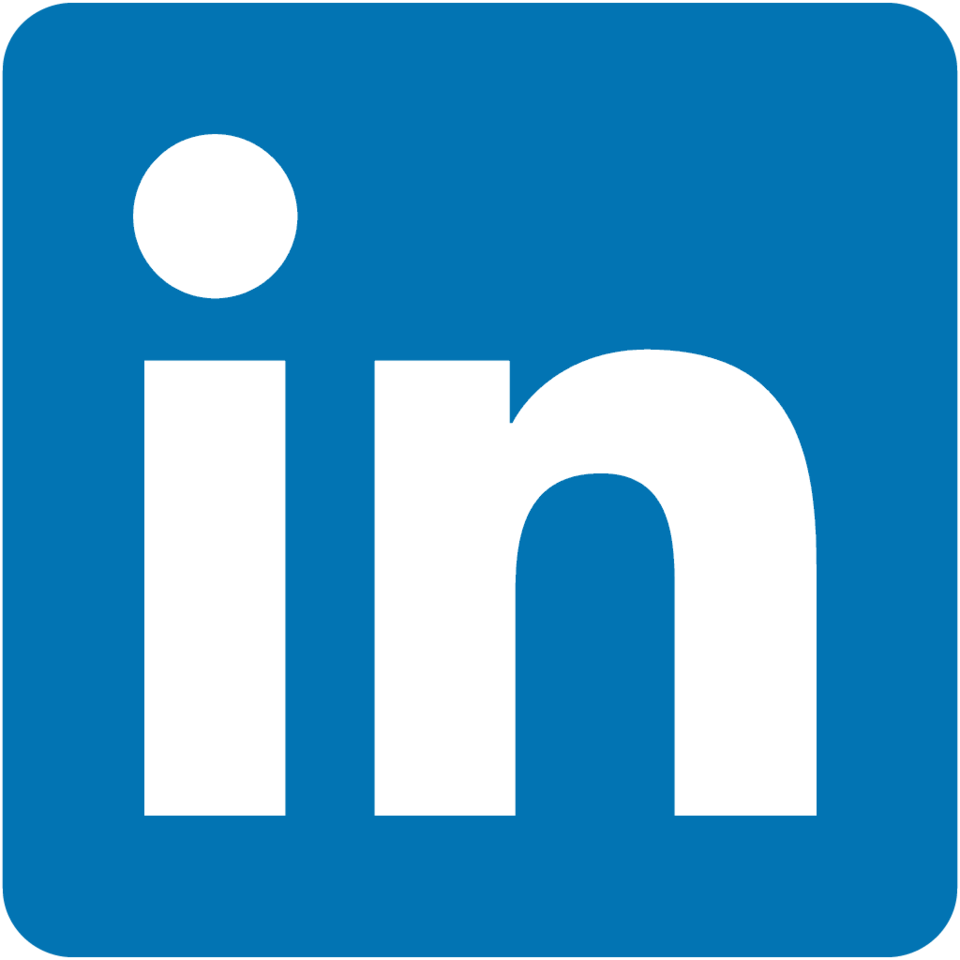

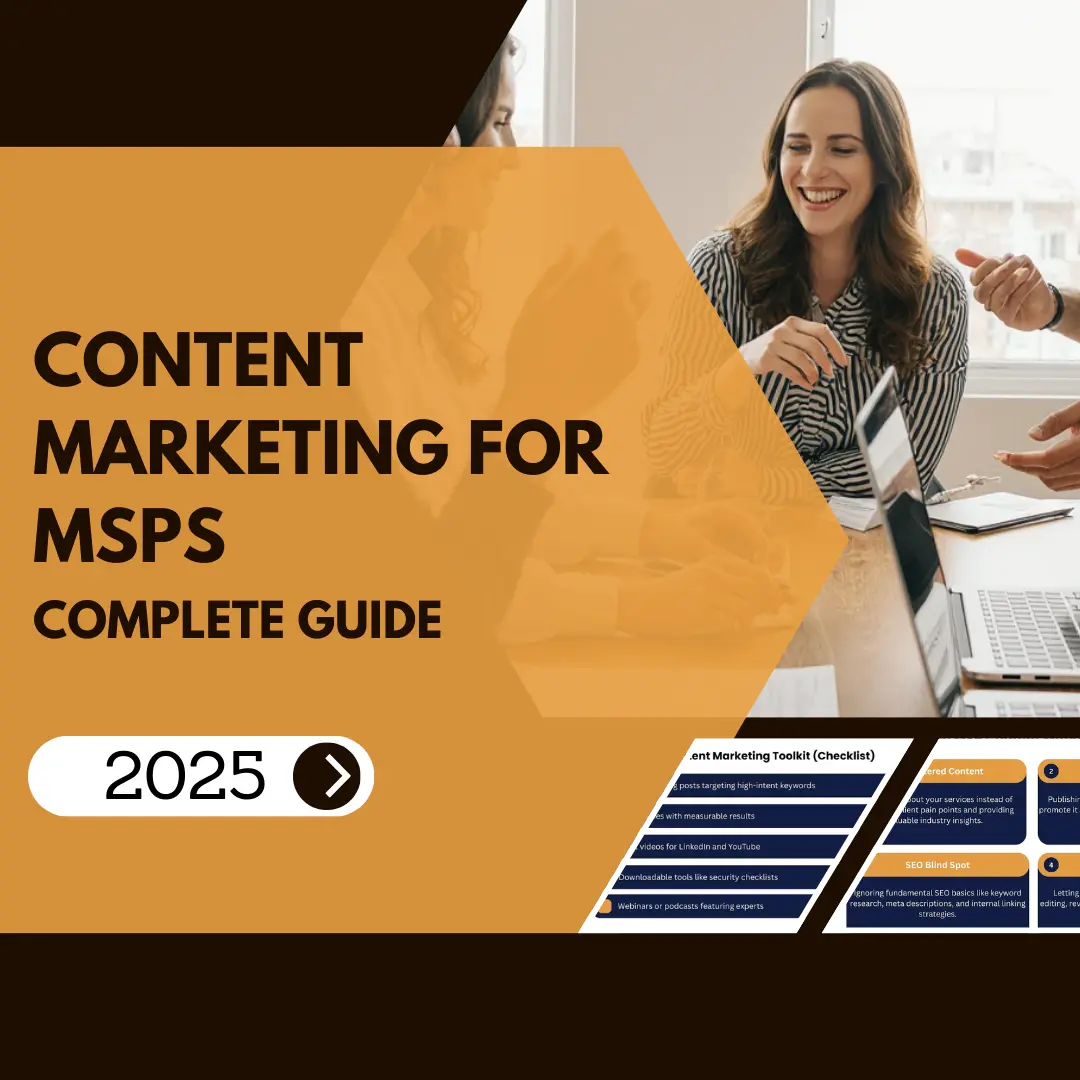
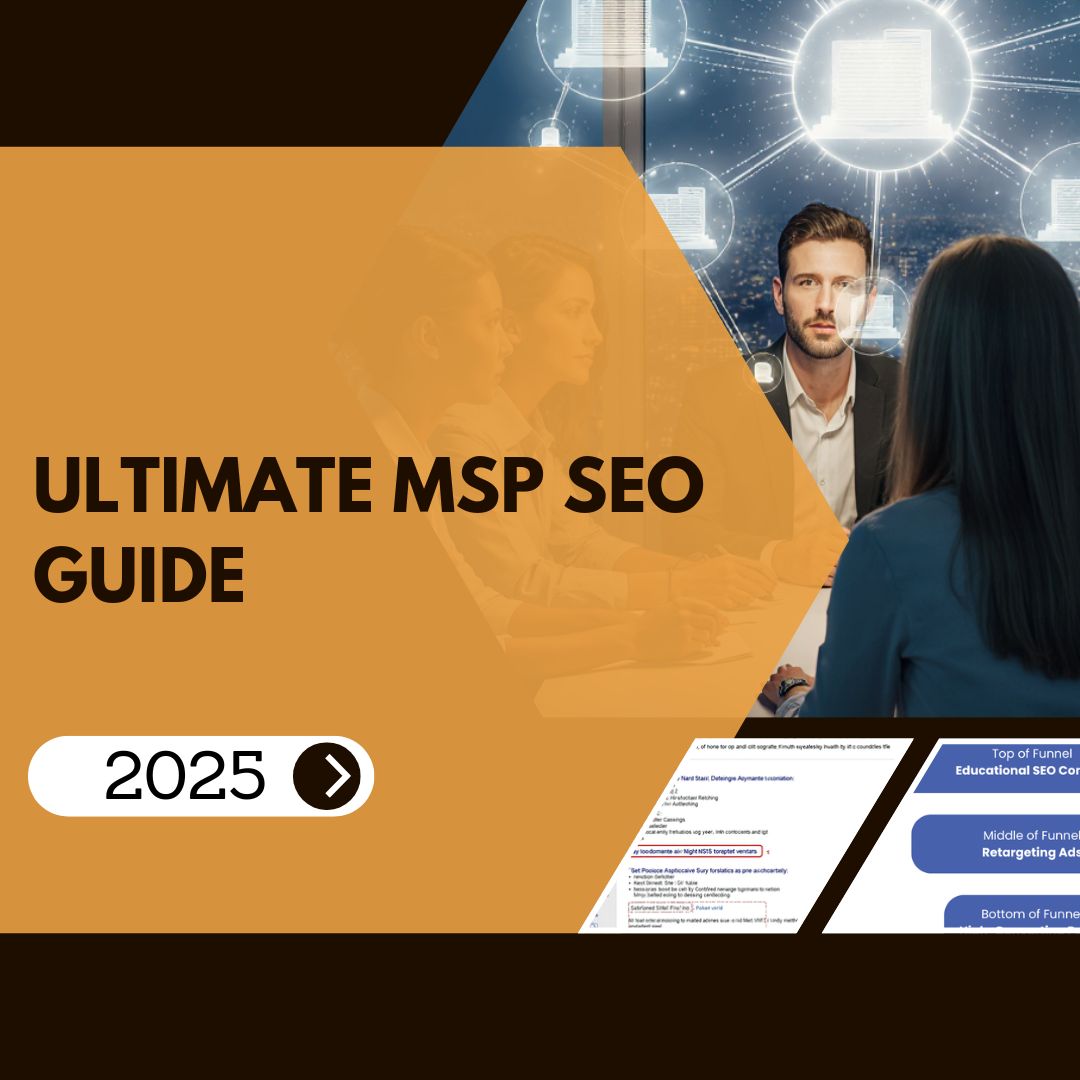
.webp)
